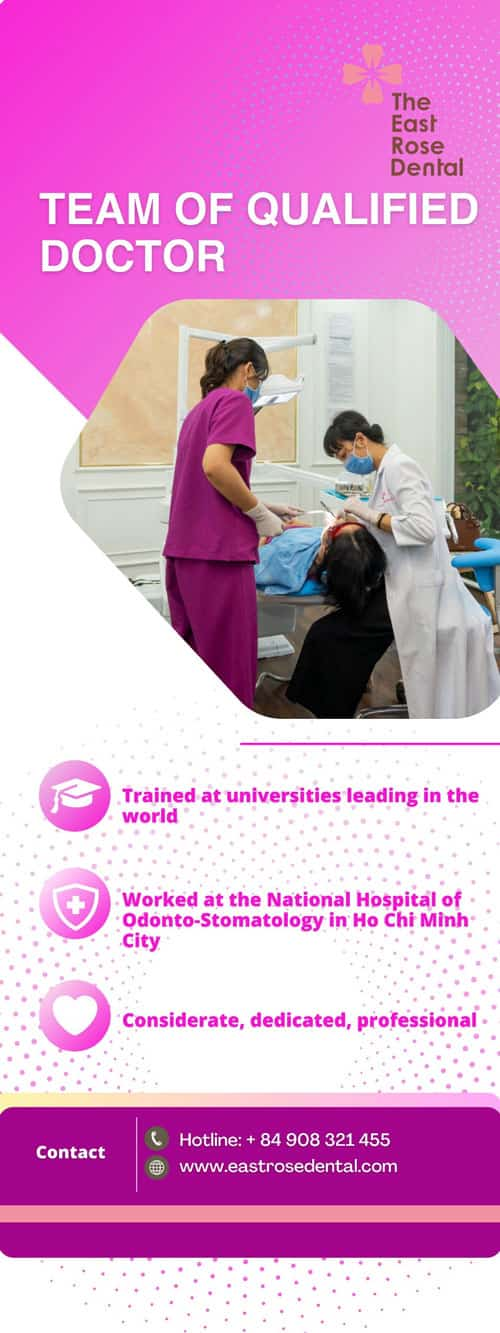8 Early Symptoms of Gum Cancer and Treatment Methods
Gum cancer is a dangerous oral disease that is often overlooked due to its unclear early symptoms. Early recognition of warning signs can help with timely treatment and minimize risks. In this article, The East Rose Dental Clinic will provide information about the early symptoms of gum cancer and the most advanced treatment methods.
Learn about Gum Cancer
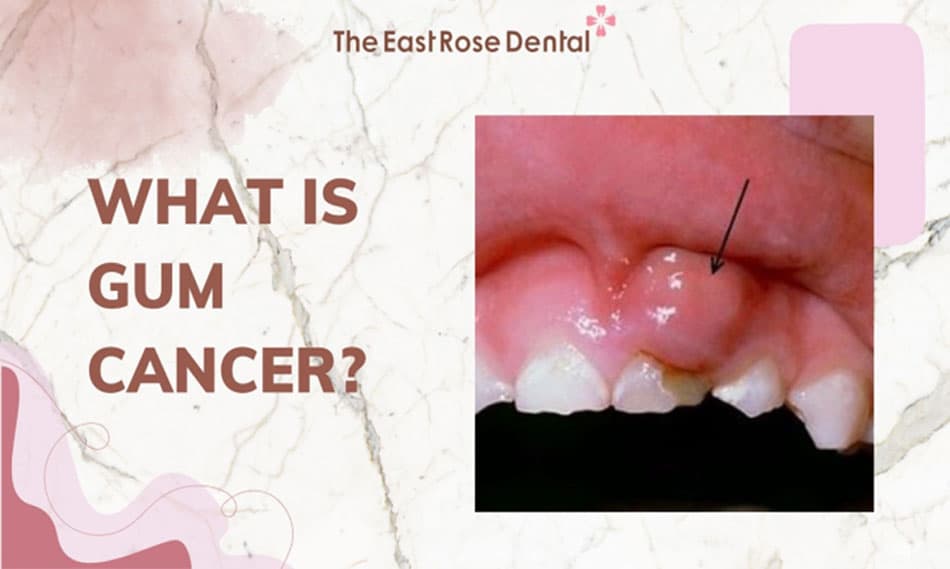
Gum cancer is a type of disease that forms when the cells of the oral mucosa grow unevenly and beyond the body's control. These cancer cells can invade surrounding tissues and spread to nearby organs if not treated promptly. Serious complications can occur, particularly when the disease metastasizes through the lymphatic system.
Additionally, gum cancer is often easily mistaken for gingivitis. Symptoms usually include the appearance of small lumps, non-healing sores that are red or white on the gums, and can cause bleeding. Therefore, it is important to pay attention to this condition for quick detection and timely treatment.
Common Causes of Gum Cancer
Gum cancer is one of the serious diseases of the mouth and can lead to serious consequences if not detected and treated in time. To understand more, we need to explore the causes behind this condition:
- Smoking and alcohol use: Smoking, including both traditional cigarettes and e-cigarettes, along with heavy and frequent alcohol consumption, increase the risk of gum cancer due to the harmful chemicals in tobacco and the negative effects of alcohol on gum tissue.
- Exposure to harmful chemicals: Chemicals in the workplace environment, such as formaldehyde and asbestos commonly found in industries like plastics manufacturing, woodworking, textiles, construction, and automotive production, can cause damage and lead to gum cancer.
- Poor oral hygiene: Improper oral care can lead to the growth of bacteria, causing gum inflammation increasing the risk of gum cancer.
- Age: Older adults have a higher risk of gum cancer compared to younger individuals. As age increases, the immune system gradually weakens, reducing the body's ability to fight disease-causing agents and making it more susceptible to the factors contributing to the disease.
8 Early Warning Signs and Symptoms of Gum Cancer
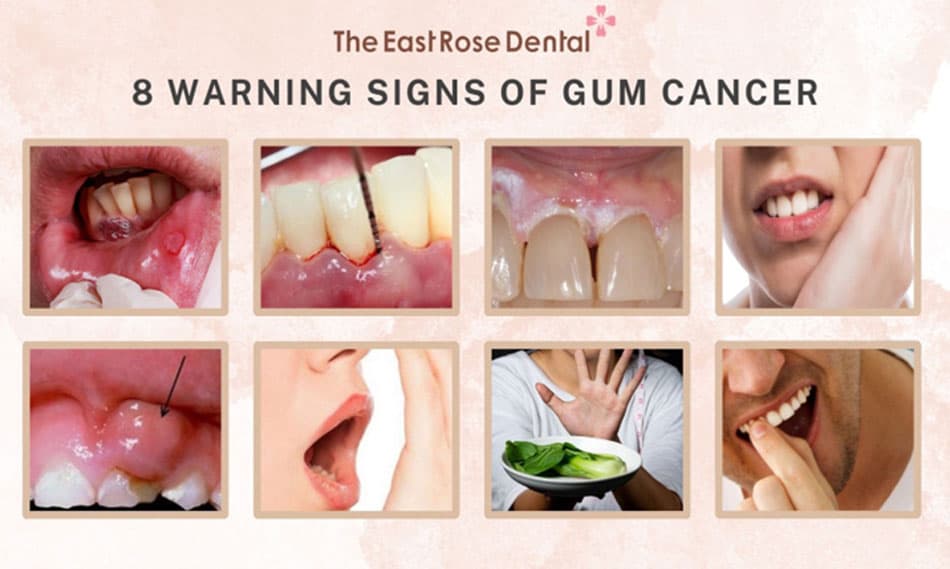
Early detection of symptoms of gum cancer can improve treatment effectiveness and increase recovery chances. Here are 8 early warning signs of this condition compiled by The East Rose Dental Clinic:
- Non-healing ulcers: The appearance of ulcers or swellings on the gums that do not heal over time. These ulcers can cause pain or discomfort and do not improve with regular oral care measures.
- Gum bleeding: Easy bleeding of the gums, especially when brushing teeth or eating. This bleeding often occurs without clear reason and persists, causing discomfort.
- Change in gum color: The gums may change color, often appearing red, white, or darkened. This color change could be a sign of abnormal cells developing in the gums.
- Pain and discomfort: Prolonged feelings of pain or discomfort in the gums or mouth. The pain may be constant or only occur when chewing, swallowing, or speaking, affecting quality of life.
- Swelling or lump: Presence of abnormal lumps or swelling on the gums. These swollen lumps may not be painful but feel firm and uncomfortable when pressed, indicating possible abnormal growth of gum tissue.
- Difficulty eating: Difficulty chewing, swallowing, or moving the jaw. This condition not only causes pain but can also lead to weight loss and nutritional deficiencies due to avoidance of eating.
- Bad breath: Persistent bad breath without clear cause. Even with thorough oral hygiene, the bad odor remains, which may be related to infection or breakdown of damaged tissues.
- Loose Teeth: Teeth becoming loose or wobbly without clear reason. This occurs due to the destruction of gum and jawbone tissues by cancerous cells, reducing the stability of the teeth.
Treatment options for gum cancer
If left untreated, the tumor can easily metastasize to other locations and become difficult to effectively treat. Below are 3 common treatment methods for gum cancer.
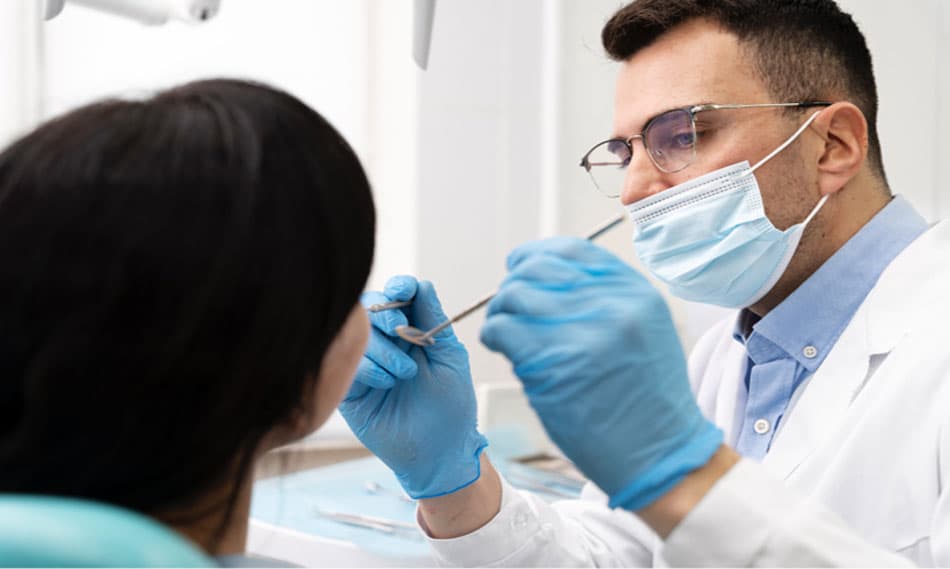
Surgical removal method for removing the tumor
This method is considered the most effective in treating gum cancer. The doctor will surgically remove the tumor along with surrounding tissues in the affected gum area. For smaller tumors, the procedure involves a minor surgical incision, whereas larger tumors may require a more extensive operation.
To prevent metastasis, the doctor may also perform lymph node dissection in the nearby area. After surgery, additional procedures may be necessary to reconstruct areas within the oral cavity.
Treatment of gum cancer with radiation therapy
This method focuses on destroying cancer cells using high-energy radiation. It is typically applied in the early stages of gum cancer, when the tumor is small. Radiation therapy is often combined with chemotherapy to optimize treatment effectiveness, aiming to eradicate cancer cells completely and prevent recurrence or spread to other areas.
Chemotherapy treatment method
Unlike radiation therapy, chemotherapy uses chemicals to kill cancer cells. Chemotherapy drugs can be used alone or in combination with other treatments to enhance effectiveness. This combination helps to thoroughly destroy cancer cells and prevent their recurrence or spread.
Complications of delaying treatment
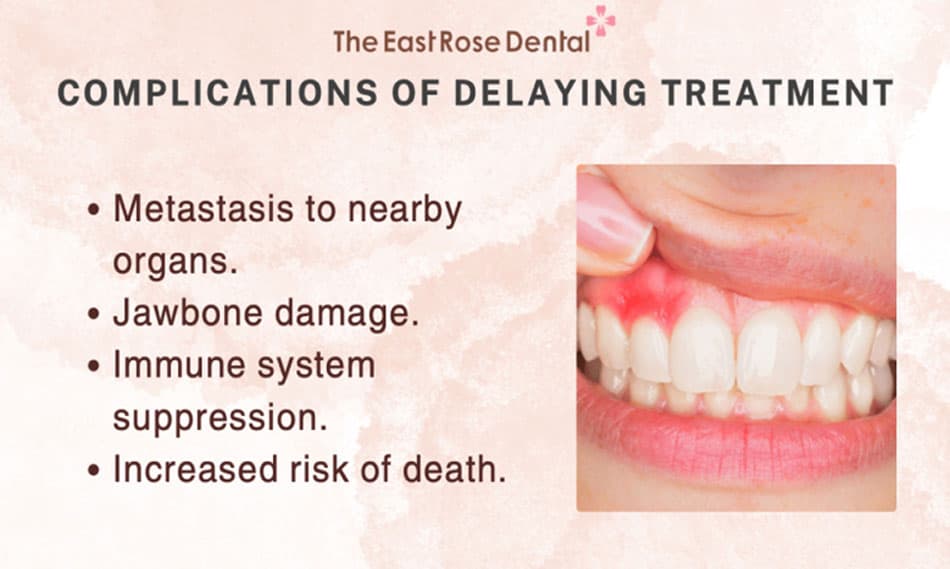
Failure to treat gum cancer promptly can lead to the risk of permanent tooth loss and severe consequences. Here are some specific complications if not treated in time:
- Metastasis to nearby organs: Cancer cells can spread from the gums to surrounding areas such as the jawbone, tongue, and throat. This increases the complexity of the disease and reduces the chances of successful treatment.
- Jawbone damage: Gum cancer can destroy the jawbone, leading to tooth loss and facial deformities. This particularly affects eating and chewing, especially aesthetically.
- Immune system suppression: The development of cancer weakens the immune system, making the body more susceptible to infections and other diseases. Immune system suppression complicates treatment and increases the risk of contracting dangerous infections.
- Increased risk of eath: If gum cancer is not treated, the disease can progress to an incurable stage, leading to death. Early detection and treatment are crucial factors in improving survival chances and patient recovery.
Recognizing early symptoms of gum cancer can improve treatment effectiveness and increase recovery chances. If you notice any signs, please consult a healthcare professional promptly for advice and timely treatment. We hope this article from The East Rose Dental Clinic has provided you with valuable insights to safeguard your oral health.
Services
Working Time
- Monday - Friday: 08:00 - 19:00
- Saturday: 08:00 - 18:00
- Sunday closed
Contact Info
- Hotline 1: (+84) 908 321 455
- Hotline 2: (+84) 931 857 885
- Mobile: (+84) 8 3925 8778
- Phone: (+84)2 838 258 778
- info@dentalrose.net
- rosedentalclinicvn@gmail.com
 English
English  Tiếng Việt
Tiếng Việt
